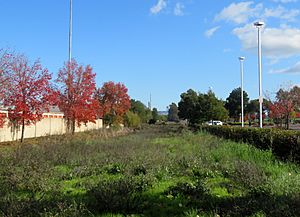San Francisco and North Pacific Railroad facts for kids

San Francisco and North Pacific Railroad Station House-Depot, Tiburon, California
(on the National Register of Historic Places as the Peter Donahue Building) |
|
| Overview | |
|---|---|
| Locale | Northern California, USA |
| Dates of operation | 1869–1907 |
| Successor | Northwestern Pacific Railroad |
| Technical | |
| Track gauge | 4 ft 8 1⁄2 in (1,435 mm) standard gauge |
The San Francisco and North Pacific Railroad (SF&NP) was a very important railway in Northern California. It was the first big railroad to use a "standard gauge" track in Sonoma County. Standard gauge means the distance between the two rails is always the same, making it easier for different trains to use the tracks.
This railroad later became the southern part of the larger Northwestern Pacific Railroad. A man named Asbury Harpending first thought of the idea. But it was Peter Donahue who bought the idea and built the railway. He hammered in the very first spike on August 30, 1869.
Contents
Early Railroads in Sonoma County
Before the SF&NP, Sonoma County had a small railroad called the Petaluma and Haystack Railroad. It was only about 1 mile (1.6 km) long. This short line connected the city of Petaluma to ferry services. These ferries took people across the bay to San Francisco from Haystack Landing on the Petaluma River. At first, it had a locomotive, but after it exploded in 1866, horses pulled the coaches!
Building the SF&NP Lines
The SF&NP started building its tracks in 1869, heading north from Petaluma. They couldn't agree on a good spot in Petaluma for their main station. So, they built a new ferry spot called Donahue Landing on the Petaluma River.
By 1870, the train service reached Santa Rosa. Two years later, in 1872, it went even further north to Cloverdale.
Branch Lines and New Ferry Terminals
In 1874, a new company was formed to build a branch line. This line went from Fulton to Guerneville on the Russian River. This branch was finished in 1877.
The SF&NP continued to grow. In 1879, the main line was extended south through Petaluma to San Rafael in Marin County. Then, in 1882, another company helped extend the line about 3 miles (5 km) more. This extension led to a brand new ferry landing in Tiburon. By 1884, all SF&NP ferry services moved to Tiburon. Donahue Landing slowly became a quiet, rural area.
Expanding North and West
In 1886, the Cloverdale and Ukiah Railroad was created. Its goal was to extend the SF&NP north to Ukiah in Mendocino County. Trains started running to Ukiah in 1889.
Another branch line was built in 1889. This one went from Santa Rosa to Sebastopol. It was completed in 1890.
The End of SF&NP and New Beginnings
The SF&NP faced tough times, especially during a financial crisis in 1893. In 1898, a larger company called the California Northwestern Railway Company leased the SF&NP. This company was part of the Southern Pacific Railroad. Southern Pacific wanted to reach the redwood lumber mills near Humboldt Bay.
The California Northwestern Railway helped connect the SF&NP lines to other railroads. They also extended the tracks further north to Willits. Finally, in 1907, the San Francisco and North Pacific Railroad officially merged into the new Northwestern Pacific Railroad. This new railroad combined many smaller lines to create a larger, more connected system.
Locomotives of the SF&NP
The San Francisco and North Pacific Railroad used many different types of steam locomotives to pull its trains. Most of their engines were of the "4-4-0" type, which means they had four small wheels at the front, four large driving wheels in the middle, and no wheels at the back. Some of their locomotives were named after cities they served, like Santa Rosa and Petaluma, or important people, like Peter Donahue. Later, they also acquired "4-6-0" type locomotives, which had six driving wheels for more power. Many of these engines continued to work for the Northwestern Pacific Railroad after the merger.
Images for kids




